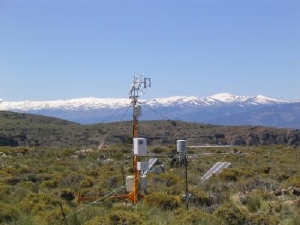Mar 27 2008
The implementation of the Kyoto Protocol has raised, among other pressing matters, the need of getting to know the annual levels of carbon in different earth's ecosystems. Scientists connected with the CEAMA-Andalusian Centre for the Environment (University of Granada-Andalusian Council) are studying these levels in semiarid Mediterranean scrubland, situated in Eastern Andalusia, whose results are comparable to wide regions of the world.
 Measuring tower of CO2 ecosystem-atmosphere interchange by means of the eddy covariance technique. (Credit: A. Marín)
Measuring tower of CO2 ecosystem-atmosphere interchange by means of the eddy covariance technique. (Credit: A. Marín)
These researchers have analysed for the first time the CO2 level in carbonated semiarid systems. The interest of the work lies in the knowledge of the CO2 production processes and their absorption and in the conservation of one of the richest ecosystems of Spain.
One of the most recent studied on the subject is the doctoral thesis “CO2 interchanges between atmosphere and karst ecosystems: Applicability of the commonly applied techniques”, read by Penélope Serrano Ortiz and led by Doctors Andrew S. Kowalski and Lucas Alados Arboledas.
The work, supported by the “Carbon and water balance in Mediterranean thicket ecosystems in Andalusia: Effect of the climatic change” project, has permitted to quantify and identify the processes involved in carbon annual balance in a semiarid carbonated substrate ecosystem, situated in Sierra de Gádor (Almeria). After three years of observation of this ecosystem (2004-2006), through the use of the most advanced techniques (attached photo), have permitted to estimate the annual carbon balance. The carbon balance of this type of ecosystem has been checked for the first time, revealing that it acts as a CO2 drain which assimilates approximately 25 g C m-2 a year (between 10 and 20 times lower than arable land and tree ecosystems respectively).
Extreme climate
What is the meaning of this in an area characterized by a scrubland vegetation and a dry climate" Up to now, when it came to devise measures to prevent climatic change, they used to value tree ecosystems especially; that is the origin of the emphasis made in the reforestation and forestation of neglected agricultural land. But little attention had been paid to other ecosystems, such as the thicket ecosystem object of this study, which represents more than half the forest area of Andalusia (where a great part of the biological diversity of the Mediterranean ecosystems gathers together).
In that respect, besides defining the CO2 assimilation capacity of the studied thicket area, Serrano's thesis has proved how rain distribution conditions the functional nature of the studied ecosystem and how the duration of the drought period and, therefore, the water content, determinates the duration of the CO2 geochemical emissions, through soil ventilation.
It proves that CO2 production is not only related to vegetation, but also to geochemical emissions which increase in dry seasons.
“The hypothesis formulated in this work -says Serrano- is that the emissions are a consequence of a ventilation phenomenon of the carbonated system's macro-pores, which appear to be connected with wind speed. In this line, certain studies on degasification phenomenon in caves and turbulent CO2 interchanges with the atmosphere, carried out by Sergio Sánchez Moral and Soledad Cuezva Robleño (Spanish Museum of Natural Sciences, CSIC) in the Altamira Cave, endorse the theory of the existence of CO2 geochemical flows in ecosystems situated in karst substrate”.
Politics and ecology
CO2 is one of the main greenhouse gases which contributes to the rise of earth's temperature. Serrano Ortiz's study is the first one focused on carbonated semiarid ecosystems and has proved that they act as CO2 drains, due to the action of the thickets, and as CO2 geochemical generators in dry periods (especially worrying if we reach the temperature rise predicted by climatic change models). His work provides data of C (carbon) flows in key ecosystems for biodiversity conservation, as well as for the negotiations related to CO2 emissions.